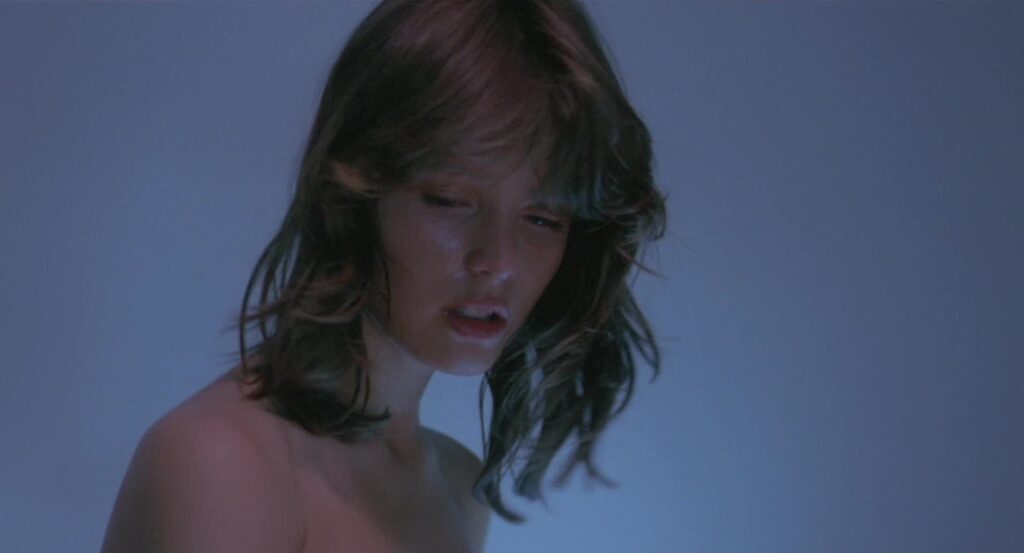
It would be too easy to sum up Eckhart Schmidt’s film Der Fan (1982) as a horror movie about a teenaged girl’s obsession with a pop star. At every turn Schmidt adds complexities to this premise that, in and of itself, is hardly original. Der Fan is a horror film, but one that works as a character study. Der Fan is about its protagonist, Simone (Désirée Nosbusch), and her subjective experience of events more than it is about its images of gore and sex.
The first act of Der Fan focuses on Simone’s idolization of the pop star R. (Bodo Steiger) from afar. Simone’s whole world has become her waking dreams and fantasies about R.; having discarded any real care for her schooling or home life some time ago. Schmidt structures this act as a series of episodes that demonstrate the causes for Simone’s retreat into these fantasies and how, in turn, these fantasies exasperate their own causes. It’s a cycle that the audience is forced to endure with Simone until she finally runs away to Munich to find her beloved idol.
It’s clear that the institutions that Simone is trying to escape (school and family) are patriarchal systems. But Schmidt complicates matters with a single shot of the posters that adorn Simone’s bedroom wall. The camera pans over a poster of Germans giving the Nazi salute at a rally some time in the thirties or forties. But as the camera approaches what would be the center of this fascist image there is a giant pin-up of R. Suddenly the fanaticism and terror of the Nazi regime is being equated to the worship of pop culture icons. The revelation here is that Simone, in her bid for escape from her school and parents, has thrust herself unknowingly into an inherently patriarchal structure of which she is a co-author.
The second act of Der Fan follows Simone as she hitchhikes to Munich where she meets R. outside of a taping of the television show Top Pop. Simone is assaulted en route to her fateful rendezvous where she promptly passes out upon being approached by the subject of her fixations. Now inside the television studio Schmidt’s camera stays locked on Simone, grounded entirely in her perspective, as she observes R. and is led by him from one stage of recording to the next. Schmidt only shows those things that Simone would see or hear, creating an entirely subjective space. Yet, beneath this living fantasy, there persists a hint of danger that Simone remains ignorant of.
The final act of Der Fan occurs at R.’s remote getaway outside of Munich. Simone is seduced in one of the most hauntingly awkward sex scenes ever put on film. As Simone begins to realize that R. is more of a rake than a romantic, as he begins to leave her and cast her aside like some old toy, Simone strikes the pop star on the back of the head with a statue. This moment of murder is the moment that Simone realizes that she’s traded two patriarchal systems for a third.
With R. dead, Simone, still naked, strips his corpse and hauls R.’s carcass into the kitchen. Here Simone begins to ritualistically dismember R. and drink his blood. It’s a powerful sequence that is as erotic as it is unsettling. For Schmidt this moment of cannibalism is a moment of feminist conquest. The patriarchal system R. represented that Simone herself became complicit in is literally dismantled and devoured by its victim. The cool blue light and the hum of the synth score make this a dream space whose euphoria feels deadly and threatening. Simone eats R. and grinds his bones to dust. It’s as if R. never existed.
And yet, R. does exist. In the final moments of Der Fan Simone reveals, via voice over, that she is pregnant with R.’s child. Simone phrases this internal dialogue as if she were talking to R. about R. when really she is speaking of the baby she will have. It’s an affectively chilling moment that suggests R.’s total subjugation by Simone; he was her physical sustenance and now he will be reborn in an image to her liking and under her control. Even though Der Fan deals with Simone’s anti-patriarchal quest it’s nevertheless a kind of tragedy. Through all of this it is clear that Simone is gravely ill; her sanity is tenuous at best.
Despite some superficial similarities Der Fan doesn’t really have much in common with The Fan (1981) or The King Of Comedy (1982). The legacy of Der Fan isn’t really felt until the 2010s in films like Agnieszka Smoczyńska’s The Lure (2015) and Julia Ducournau’s Raw (2016). These twenty-first century horror films employ their genre as a means of creating tragic feminist portraits set in an oppressively patriarchal state. Der Fan was, in 1982, ahead of its time.
